Ever walked into a room and instantly felt your mood lift? That’s the power of colorful, lively spaces. Bright hues and playful designs can turn a dull area into a joyful retreat. Take those yellow chairs in a gray dining room—they didn’t just add color; they sparked happiness.
This feel-good approach to design isn’t just a passing fad. With over 34 million posts on social media, it’s clear people crave spaces that boost their spirits. The right mix of colors and textures does more than look pretty—it supports mental well-being.
The best part? You don’t need a big budget to create a home that radiates joy. Small changes, like bold accents or cheerful artwork, can make a huge difference. Later, we’ll dive into the science behind why these spaces work so well.
Key Takeaways
- Bright, lively designs can instantly improve your mood.
- Social media shows millions embrace this uplifting style.
- Colorful elements, like yellow chairs, transform dull spaces.
- This approach supports emotional well-being.
- Affordable updates can create a happier home.
What Is Dopamine Decor? The Trend That Sparks Joy
What if your home could make you smile the moment you walk in? That’s the idea behind this uplifting approach to design. It’s not just about looks—it’s about creating spaces that feel as good as they look.
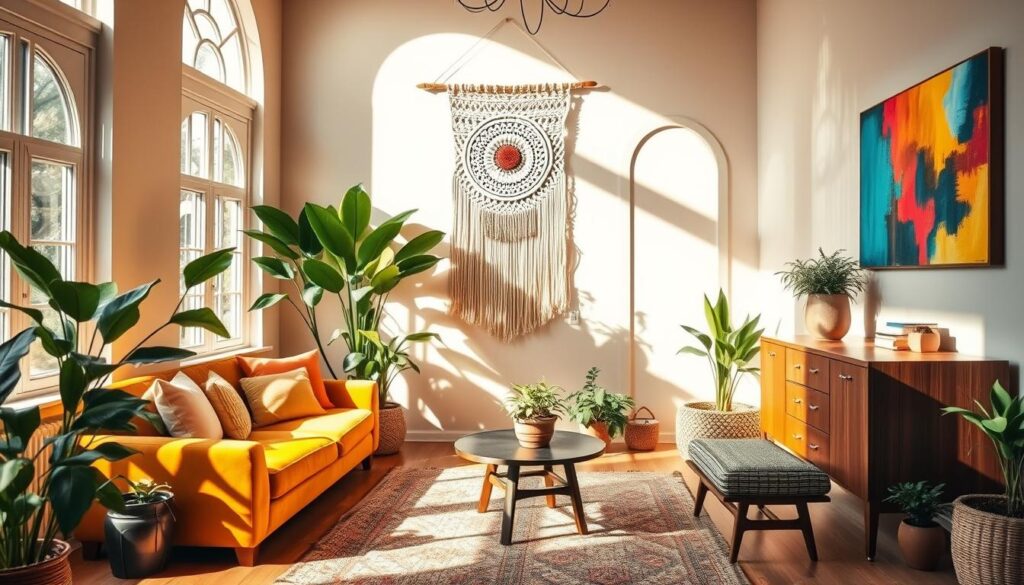
From Dopamine Dressing to Décor: The Origins
This trend started in fashion. Bright, bold outfits—nicknamed “dopamine dressing”—boosted wearers’ moods. Soon, TikTok users adapted the idea for their homes. Think rainbow bookshelves or neon throw pillows.
Jensen & Co Interiors notes the shift: “Post-pandemic, people crave spaces that comfort and energize.” It’s less about trends and more about what makes you happy.
How Dopamine Décor Differs from Minimalism
Minimalism focuses on “less is more.” Joyful design? It’s “more is more.” Here’s how they compare:
| Minimalism | Joyful Design | |
|---|---|---|
| Color Palette | Neutrals only | Rainbow brights |
| Decor | Few, functional items | Layered, meaningful pieces |
| Goal | Calm and order | Energy and personality |
ELLE DECOR showcased a color-drenched Aspen home—proof that rules are meant to be broken. The takeaway? Your space should reflect your joy, not a design textbook.
The Science Behind Dopamine Decor: How It Boosts Happiness
Science confirms what your heart already knows—colorful spaces spark joy. But it’s not just a feeling; your brain reacts to vibrant designs in measurable ways. Let’s explore the biology and research that make this magic happen.
Neurobiology of Joy: More Than Just One Chemical
Semir Zeki’s fMRI scans revealed something fascinating. When people view beautiful art, their reward centers light up. This triggers a cocktail of neurotransmitters—not just dopamine, but serotonin and oxytocin too. Together, they create that warm, happy buzz.

Light therapy studies add another layer. Bright environments mimic sunlight, boosting alertness and mood. As one researcher noted, “It’s like giving your brain a morning coffee without the jitters.”
Color, Patterns, and Emotional Well-Being
Sherwin-Williams found that yellow kitchens increase energy, while blue bedrooms promote calm. But it’s not just about single hues. The Oxford wine-tasting study showed something unexpected. Participants rated the same wine 15% tastier in vibrant rooms versus neutral ones.
Why? Crossmodal Lab’s work suggests patterns and color enhance sensory experiences. A striped rug or polka-dot pillow isn’t just fun—it wakes up your senses. The result? A home that feels as lively as it looks.
Key Principles of Dopamine Decor
Your home should feel like a burst of happiness every time you step inside. The secret? Combining bright colors, playful layers, and meaningful details. Here’s how to create spaces that energize and inspire.
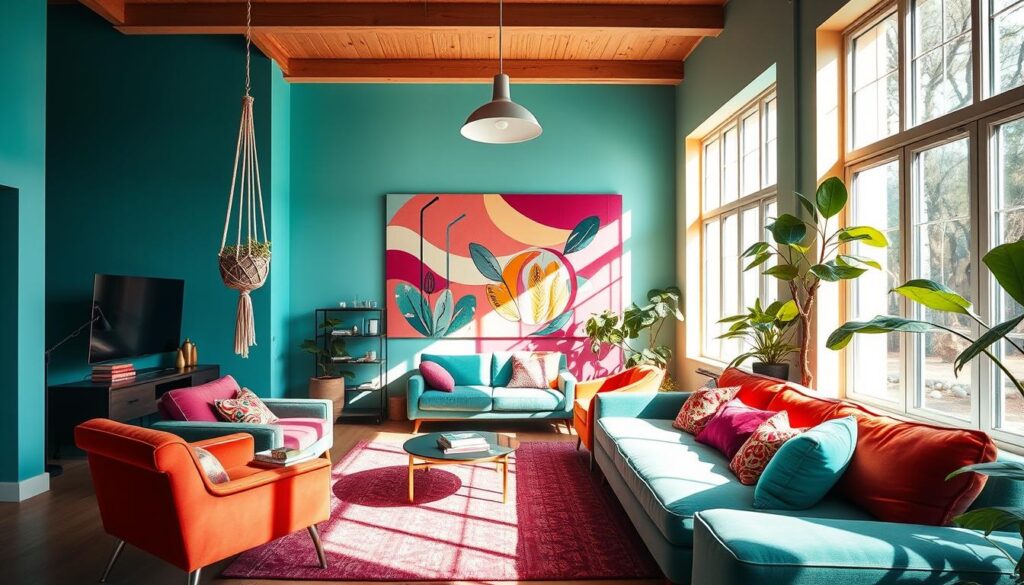
Bright Colors That Energize Your Space
Jewel tones like emerald green or fuchsia add instant energy. A cobalt blue accent wall or a citrine-yellow chair can transform a room. Hulala Home’s velvet loveseats prove rich textures amplify color impact.
Lisa Corti’s Milan apartment showcases how saturated hues feel like sunshine. “Color isn’t just seen—it’s felt,” she says. Start small with vibrant throw pillows or a statement lamp.
Bold Patterns and Playful Textures
Mix stripes, florals, and geometric prints for visual excitement. Try a polka-dot rug paired with a zigzag pillow. Haitian metalwork wall art adds handcrafted charm.
Don’t forget tactile elements:
- Fuzzy throws for cozy evenings
- Nubby jute rugs underfoot
- Glossy ceramic vases for contrast
Personalized Touches That Tell Your Story
A gallery wall of childhood photos or travel souvenirs makes a space uniquely yours. Frame kids’ artwork or display vintage finds. Personalized spaces spark joy because they reflect *you*.
One designer transformed a client’s seashell collection into a coffee table centerpiece. “It’s not decor—it’s a memory museum,” they shared. Your home should celebrate what you love.
How to Start with Dopamine Decor: A Step-by-Step Guide
Ready to turn your home into a happiness hub? Here’s how to begin. You don’t need a full overhaul—small, intentional updates can make feel your space instantly brighter. Follow these steps to create a home that sparks joy every day.
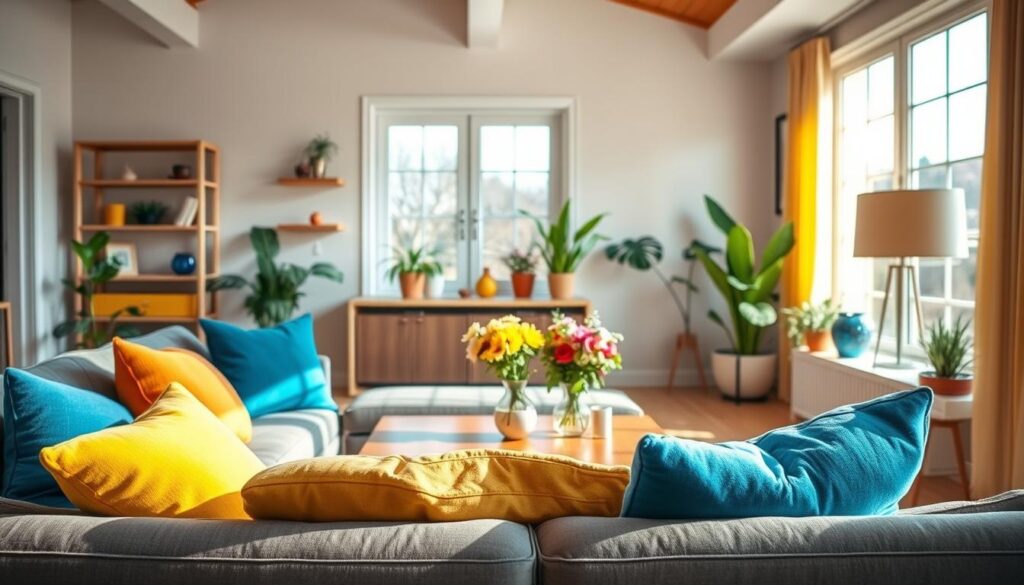
Step 1: Identify Your Joy Triggers
Start with a “joy audit.” Walk through your room and note what makes you smile—a sunny spot by the window, a favorite artwork, or a cozy reading nook. Decorilla suggests asking: “Does this item lift my mood or just take up space?”
Try these quick fixes:
- Swap neutral curtains for colorful textiles.
- Display souvenirs or photos that hold happy memories.
Step 2: Choose a Focal Point
Pick one area to transform first—a bookshelf, entryway, or small room. An office-to-sitting-area makeover proved that even 50 square feet can become a mood-boosting retreat. Measure your space and sketch layout ideas.
Step 3: Build a Cohesive Color Palette
Use a color wheel to pair complementary hues. For example, teal and coral create energy, while lavender and sage offer calm. Test shades with removable wallpaper or painted swatches. “Colors should flow naturally from room to room,” advises a Sherwin-Williams designer.
Pro tip: Pinterest boards help visualize combinations before committing.
Dopamine Decor on a Budget: Affordable Ways to Feel Good
Who says a joyful home has to break the bank? With creativity and smart choices, you can design a space that lifts your mood—without overspending. Here’s how to embrace vibrant style while staying *affordable*.
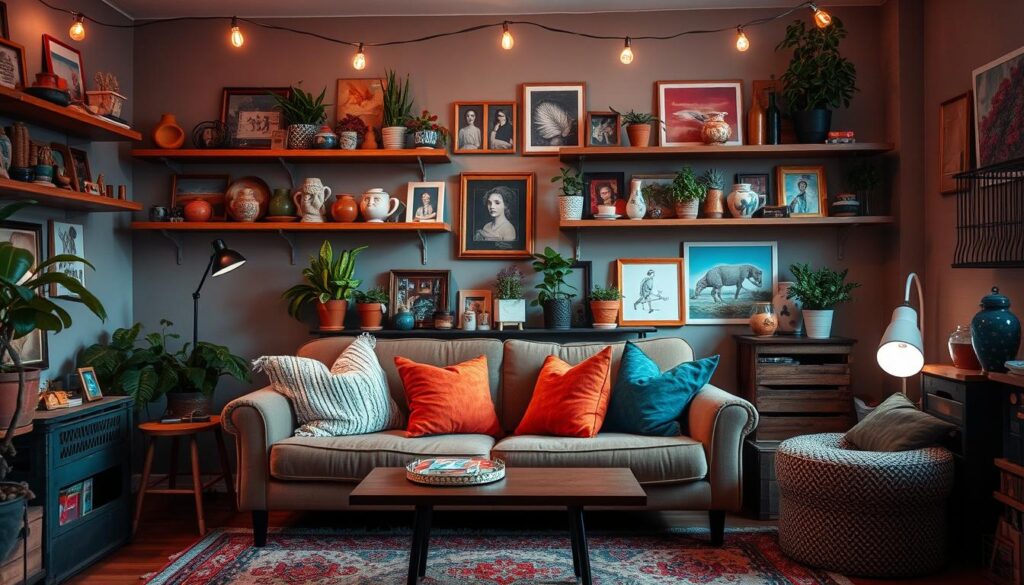
Thrifting and Repurposing Favorite Items
Thrifting is a goldmine for unique finds. Scout local estate sales or Buy Nothing groups for vintage frames, colorful ceramics, or quirky lamps. One designer turned a $15 Ikea lamp into a statement piece with bold paint and a fringe mirror.
Repurpose what you already own:
- Paint old furniture in energizing hues like tangerine or teal.
- Turn travel postcards into a framed gallery wall (cost: under $20).
- Use mismatched plates as wall art for a playful touch.
DIY Projects for Personalized Accents
DIY adds heart to your home. Try no-sew pillow covers from thrifted scarves or create a plant propagation station with recycled jars. “Handmade details make spaces feel uniquely yours,” notes a Brooklyn-based stylist.
Quick projects to try:
- Stencil patterns onto plain curtains for instant vibrancy.
- Upcycle wooden crates into floating shelves.
- Dip-dye napkins for a pop of color at mealtime.
Pro tip: Mix high and low—pair a thrifted chair with a new, bold cushion for balance.
Dopamine Decor Mistakes to Avoid
Even the happiest spaces need careful planning to avoid common missteps. While vibrant colors and patterns boost mood, going overboard can create chaos. Here’s how to dodge pitfalls and craft a home that’s joyful—not jarring.
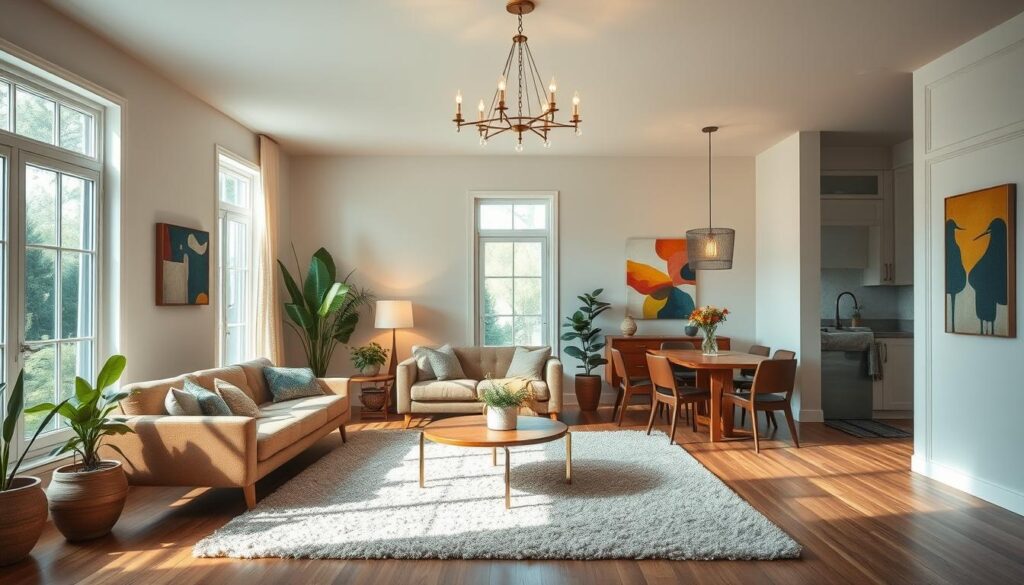
Overstimulation: Balancing Vibrancy and Harmony
Too many bright colors in one space can feel overwhelming. A study found that colorful TV rooms prolonged screen time by 20%, proving distraction risks. Start with a neutral base—like white walls—then layer in bold accents.
Lighting matters too. Poorly lit rooms amplify visual clutter. Combine overhead lights with warm lamps for balance. For high-focus areas like home offices, limit patterns to one wall or use ergonomic furniture in calming hues.
Ignoring Functionality for Aesthetics
A joyful home should work as hard as it delights. Avoid sacrificing functionality for looks. For example, a gallery wall near your workspace might inspire, but cluttered surfaces hinder productivity.
Try these zoning strategies for multipurpose rooms:
- Use rugs or shelves to define activity areas.
- Keep addiction-risk spaces (like snack corners) minimalist.
- Choose washable fabrics for high-traffic zones.
“Design should serve your life, not just your Instagram feed,” notes a Houston-based organizer. Blend joy and practicality for a home that truly uplifts.
Real-Life Dopamine Decor Success Stories
Real homes prove that vibrant design isn’t just theoretical—it works in daily life. These transformations show how color and personality can turn ordinary spaces into joy-filled sanctuaries. From home offices to gallery displays, the results speak for themselves.
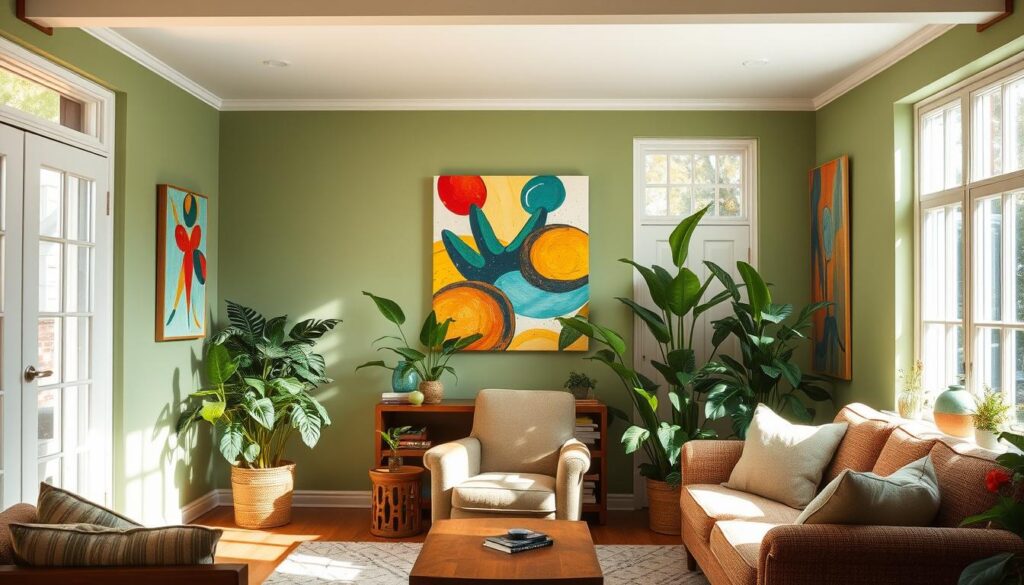
Transforming a Neutral Office into a Joyful Oasis
A San Francisco designer tackled a bland home office with Hulala Home’s velvet furniture. The $1,000 makeover included:
- Citrus-colored shelving for organization
- A fuchsia storage ottoman (dual-function seating)
- Geometric wallpaper behind the workspace
The before-and-after difference was staggering. “Clients now describe it as their ‘happy place’ instead of just a desk area,” notes the designer. This table shows key changes:
| Element | Before | After |
|---|---|---|
| Wall Color | Beige | Peach sunrise |
| Lighting | Overhead only | Rainbow glass lamp |
| Flooring | Plain carpet | Floral rug |
How a Gallery Wall Became a Daily Mood Booster
Joyce Huston turned blank walls into inspiration zones with mixed-media art. Her display includes:
- Framed marathon medals (motivation reminders)
- Children’s paintings alongside professional prints
- A rotating “feature spot” for new finds
Decorilla helped another client showcase ceramic collections as functional art. Wall displays now serve as conversation starters. As one participant shared: “I smile every time I pass my memory wall—it’s like walking through happiness.”
Patrick Mele’s Aspen home proves bold color schemes work beyond small spaces. His emerald-green dining room with coral accents shows how vibrant palettes energize large areas too.
Conclusion: Embrace Dopamine Decor for a Happier Home
Your space should be a daily dose of happiness. Science shows bright colors and playful textures boost serotonin and oxytocin—key chemicals for mental health. Start small: a yellow throw pillow or a bold artwork can ignite joy instantly.
Trends come and go, but a home that reflects *you* never fades. Join our annual design workshop or explore our Pinterest board for inspiration. The best part? There’s no wrong way to create a space you love.
Ready to experiment? Swap one neutral item for something vibrant today. Your future self will thank you every time you walk in the door.

